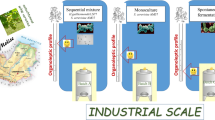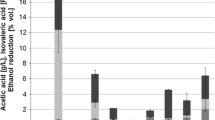Abstract
Vitis vinifera (variety Tempranillo) grapes were pressurized at 400 MPa by high hydrostatic pressure for 10 min and the effect on wild microbial populations, phenol extraction and wine composition was monitored. After treatment, the grapes were inoculated and fermented with Saccharomyces cerevisiae and several non-Saccharomyces yeasts: Schizosaccharomyces pombe, Torulaspora delbrueckii, Metschnikowia pulcherrima and Lachancea thermotolerans. S. pombe was used as sole fermentative yeast, but T. delbrueckii, M. pulcherrima and L. thermotolerans were used in sequential cultures with S. cerevisiae to completely ferment the sugars. The HHP treatment reduces strongly or eliminates wild microorganisms, especially yeasts, facilitating the growth and development of non-Saccharomyces yeasts. Thus, it helps to get either a better expression of enzymatic activities or metabolites production of non-Saccharomyces affecting wine quality.



Similar content being viewed by others
References
Abalos, D., Vejarano, R., Morata, A., González, C., & Suárez-Lepe, J. A. (2011). The use of furfural as a metabolic inhibitor for reducing the alcohol content of model wines. European Food Research and Technology, 232, 663–669.
Benito, S., Morata, A., Palomero, F., González, C., & Suárez-Lepe, J. A. (2011). Formation of vinylphenolic pyranoanthocyanins by Saccharomyces cerevisiae and Pichia guillermondii in red wines produced following different fermentation strategies. Food Chemistry, 124, 15–23.
Buzrul, S. (2012). High hydrostatic pressure treatment of beer and wine: a review. Innovative Food Science and Emerging Technologies, 13, 1–12.
Ciani, M., Comitini, F., Mannazzu, I., & Domizio, P. (2010). Controlled mixed culture fermentation: a new perspective on the use of non-Saccharomyces yeasts in winemaking. FEMS Yeast Research, 10, 123–133.
Ciani, M., & Maccarelli, F. (1998). Oenological properties of non-Saccharomyces yeasts associated with wine-making. World Journal of Microbiology and Biotechnology, 14, 199–203.
Comitini, F., Gobbi, M., Domizio, P., Romani, C., Lencioni, L., Mannazzu, I., & Ciani, M. (2011). Selected non-Saccharomyces wine yeasts in controlled multistarter fermentations with Saccharomyces cerevisiae. Food Microbiology, 28, 873–882.
Considine, K. M., Kelly, A. L., Fitzgerald, G. F., Hill, C., & Sleator, R. D. (2008). High-pressure processing-effects on microbial food safety and food quality. FEMS Microbiology Letters, 281, 1–9.
Fernández, M., Úbeda, J. F., & Briones, A. I. (2000). Typing of non-Saccharomyces yeasts with enzymatic activities of interest in wine-making. International Journal of Food Microbiology, 59, 29–36.
Francis, I. L., & Newton, J. L. (2005). Determining wine aroma from compositional data. Australian Journal of Grape and Wine Research, 11, 114–126.
Gobbi, M., Comitini, F., Domizio, P., Romani, C., Lencioni, L., Mannazzu, I., & Ciani, M. (2013). Lachancea thermotolerans and Saccharomyces cerevisiae in simultaneous and sequential co-fermentation: a strategy to enhance acidity and improve the overall quality of wine. Food Microbiology, 33, 271–281.
Kulkarni, P., Loira, I., Morata, A., Tesfaye, W., González, M. C., & Suárez-Lepe, J. A. (2015). Use of non-Saccharomyces yeast strains coupled with ultrasound treatment as a novel technique to accelerate ageing on lees of red wines and its repercussion in sensorial parameters. LWT-Food Science and Technology, 64, 1255–1262.
Loira, I., Morata, A., Comuzzo, P., Callejo, M. J., González, C., Calderón, F., & Suárez-Lepe, J. A. (2015). Use of Schizosaccharomyces pombe and Torulaspora delbrueckii strains in mixed and sequential fermentations to improve red wine sensory quality. Food Research International, 76, 325–333.
Loira, I., Vejarano, R., Bañuelos, M. A., Morata, A., Tesfaye, W., Uthurry, C., Villa, A., Cintora, I., & Suárez-Lepe, J. A. (2014). Influence of sequential fermentation with Torulaspora delbrueckii and Saccharomyces cerevisiae on wine quality. LWT-Food Science and Technology, 59, 915–922.
Morata, A., & Suárez-Lepe, J. A. (2016). Advances in food biotechnology, first edition. In V. Ravishankar Rai (Ed.), New biotechnologies for wine fermentation and ageing (pp. 288–289). West Sussex: John Wiley & Sons, Ltd..
Morata, A. (2010). Nuevas tecnologías de conservación de alimentos (p. 16). Madrid: Antonio Madrid Vicente.
Morata, A., Bañuelos, M. A., Tesfaye, W., Loira, I., Palomero, F., Benito, S., Callejo, M. J., Villa, A., Gonzalez, M. C., & Suarez-Lepe, J. A. (2015b). Electron beam irradiation of wine grapes: effect on microbial populations, phenol extraction and wine quality. Food and Bioprocess Technology, 8, 1845–1853.
Morata, A., Benito, S., Loira, I., Palomero, F., González, M. C., & Suárez-Lepe, J. A. (2012). Formation of pyranoanthocyanins by Schizosaccharomyces pombe during the fermentation of red must. International Journal of Food Microbiology, 159, 47–53.
Morata, A., Loira, I., Vejarano, R., Bañuelos, M. A., Sanz, P. D., Otero, L., & Suárez-Lepe, J. A. (2015a). Grape processing by high hydrostatic pressure: effect on microbial populations, phenol extraction and wine quality. Food and Bioprocess Technology, 8, 277–286.
Palomero, F., Morata, A., Benito, S., Calderón, F., & Suárez-Lepe, J. A. (2009). New genera of yeasts for over-lees aging of red wine. Food Chemistry, 112, 432–441.
Peinado, R. A., Moreno, J., Medina, M., & Mauricio, J. C. (2004). Changes in volatile compounds and aromatic series in sherry wine with high gluconic acid levels subjected to aging by submerged flour yeast cultures. Biotechnology Letters, 26, 757–762.
Rapp, A. (1993). Foreign and undesirable flavours in wine. En: Les acquisitions récentes en chromatographie du vin. Applications à l’analyse sensorielle des vins (pp 151–163). Paris: TEC&DOC-Lavoisier.
Santos, M. C., Nunes, C., Cappelle, J., Gonçalves, F. J., Rodrigues, A., Saraiva, J. A., & Coimbra, M. A. (2013). Effect of high pressure treatments on the physicochemical properties of a sulphur dioxide-free red wine. Food Chemistry, 141, 2558–2566.
Selli, S., Cabaroglu, T., Canbas, A., Erten, H., Nurgel, C., Lepoutre, J. P., & Gunata, Z. (2004). Volatile composition of red wine from cv. Kalecik Karasi grown in central Anatolia. Food Chemistry, 85, 207–213.
Suárez-Lepe, J. A., Palomero, F., Benito, S., Calderón, F., & Morata, A. (2012). Oenological versatility of Schizosaccharomyces spp. European Food Research and Technology, 235, 375–383.
Tao, Y., & Zhang, L. (2010). Intensity prediction of typical aroma characters of Cabernet Sauvignon wine in Changli County (China). LWT-Food Science and Technology, 43, 1550–1556.
Yen, G. C., & Lin, H. T. (1996). Comparison of high pressure treatment and thermal pasteurization effects on the quality and shelf-life of guava puree. International Journal of Food Science and Technology, 31, 205–213.
Acknowledgments
This work was funded by the Ministerio de Economía y Competitividad (AGL2013-40503-R). The authors thank J. A. Sánchez (Dept. Química y Tecnología de Alimentos), A. Villa, P. Santos (Dept. Biotecnología) and R. Domínguez (ICTAN, CSIC) for excellent technical assistance.
Author information
Authors and Affiliations
Corresponding author
Rights and permissions
About this article
Cite this article
Bañuelos, M.A., Loira, I., Escott, C. et al. Grape Processing by High Hydrostatic Pressure: Effect on Use of Non-Saccharomyces in Must Fermentation. Food Bioprocess Technol 9, 1769–1778 (2016). https://doi.org/10.1007/s11947-016-1760-8
Received:
Accepted:
Published:
Issue Date:
DOI: https://doi.org/10.1007/s11947-016-1760-8




